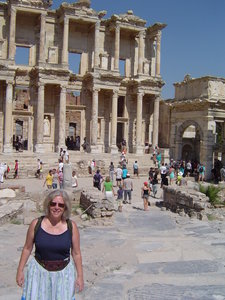Advertisement
Published: August 21st 2011

 The Celsus Library
The Celsus Library
The second biggest library in the ancient world, surpassed only by Alexandria, its collection was burned and lost. Sniff!Ephesus was our main goal if we left Istanbul at all, because Phil was keen to see remnants of antiquity, and Annabel Murray had told us Ephesus shouldn't be missed. So our travel agent built Ephesus in to his grand plan for us.
Leaving Cappadocia, we flew to Ismir, and the inherent merits of our tour arrangements became more apparent when we learned that we were being taxied, by ourselves, from the Izmir airport to the seaside town of Kusadasi, nearly an hour to the south along the coast, and delivered right to the lobby of our next hotel. What a luxury! And what a change from that first crowded hour in Istanbul going from the airport to the Sultanahmet in a train so crammed that Phil and Wai had to stand the whole way, bracing the luggage with their legs.
Ephesus was a more intense journey through time and history than I had expected. The city is believed to have been first settled by the Amazons, warrior women of amazing prowess, who, according to our guide, reputedly cut off their right breast so it wouldn't impede their archery.
The Feminism of the 1970s seemed pretty mild in

 Entering Ephesus
Entering Ephesus
In the distance is the State Agora where religious, social and political meetings were held, and behind that the Odeon.comparison! I'd rather pledge to be bra-less than breast-less.
However, I have since read that there is nothing in the art which represents the Amazons to indicate this breastlessness was true. However, their right breast area is usually covered, so I'll leave you to ponder this.
By 1000BC, Ephesus was a Greek Colony, it was later conquered by the Lydians and then the Persians. It was Greek again under Alexander the Great, Roman under the Emperor Augustus, plundered by the Goths in 262AD, and eventually became a base for the early Christians, visited by Saint John and Saint Paul and allegedly by the Virgin Mary.
Ephesus was built as a port on the Aegean Sea, but the river flowing to the sea there eventually silted up, pushing the coastline away and turning the area into a malaria-ridden swamp which was finally abandoned. Over time, the city was entirely covered with silt and it was only rediscovered in the late 1800s during the construction of the Istanbul-Baghdad railroad. Since then it has been excavated and reassembled in fits and starts. It's believed that much of it still lies beneath the silt.
Of course, I could only convey

 Christian symbol
Christian symbol
The circular symbol inscribed on this rock holds a code. Each of the individual symbols to the left of it can be traced within this one megasymbol, and together it's a sign used by the early Christians.much of this to you because we bought a picture book on Ephesus when we were walking through. Concentrate as I might, there was such a flood of names and details during the tour that I was at a loss to write about some of my photos without consulting the book for names and meanings.
I hope you enjoy this mini-tour of Ephesus. In this case, I'll leave you with the pictures.
Advertisement
Tot: 0.191s; Tpl: 0.046s; cc: 11; qc: 49; dbt: 0.0945s; 1; m:domysql w:travelblog (10.17.0.13); sld: 3;
; mem: 1.1mb

 The Celsus Library
The Celsus Library
 Entering Ephesus
Entering Ephesus
 Christian symbol
Christian symbol

































Michelle Cavanagh
non-member comment
The Ancient World
No wonder I love history so much - it's just fascinating. Can't wait to talk to you about all this when you get back!! M xx